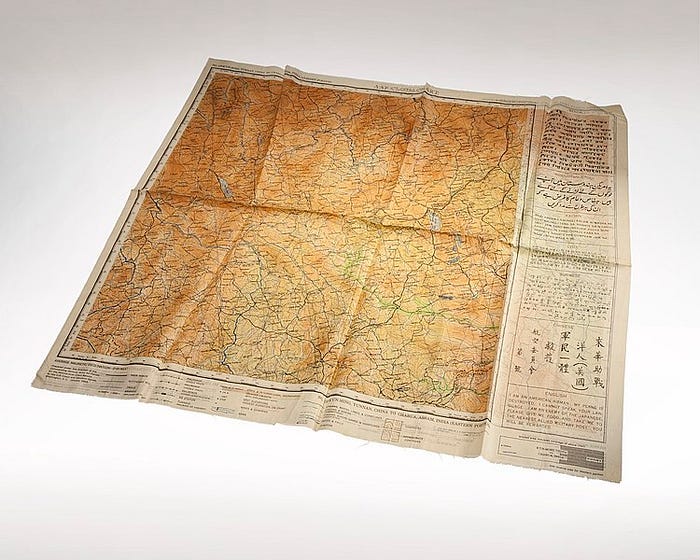Why Silk Has Been Greatly Desired By Warriors Throughout Time
More than fashion: it can heal, protect, improve aim, and help prisoners navigate to freedom

It’s easy to understand why gold has been valued by humanity throughout history as a store of wealth. The rare metal has a special shine and sparkle to it. Therefore, you might consider silk the gold of fabric.
It shimmers as well. Plus, it’s light, form-fitting, and surprisingly strong. Like gold, silk trades at a premium. While it only makes up a fraction of a percent of textiles traded, it brings in billions of dollars with the cost of raw silk about twenty times that of raw cotton.
And this is nothing new. It’s always been considered a desired product.
As Peter Frankopan notes in The Silk Roads: A New History of the World, ancient China used the fabric to pay tribute to the Xiongnu Empire. Innately, the Chinese hoped the rich fabric would civilize the Xiongnu whom they considered barbarians.
Also, the Han Dynasty used silk to pay their soldiers. Logically it makes sense. Grain can go bad, and not every region accepted coins, but the shiny fabric transcended everything.
Frankopan says, “Silk became an international currency, as well as a luxury product.” And the shiny material traveled along the international trading route, which became known as the Silk Road. It even made it to ancient Rome, and they paid exorbitantly for it.
Pliny the Elder complained that the prices were a hundred times their actual cost. Furthermore, the Empire spent a hundred million sestertius per year on it, which worked out to over ten percent of the annual Roman budget.
Although it’s more than a lovely material. Warriors throughout time have cherished silk for its practicality, and they still do.
Ancient Warriors And Silk
The Ancient Greeks and Romans had little battlefield medical care, but they had a handy tool to seal up wounds: silk from spiderwebs.
Furthermore, Genghis Khan’s soldiers treasured it. Author Jack Weatherford says, “For the Mongols it was a highly practical commodity.”
First, it was important for hygiene. In Genghis Kahn and the Quest for God, Weatherford explains the dry cold nature of Mongolia’s weather made bathing less than desirable. Silk garments could be so tight, lice and other insects couldn’t penetrate it. Their eggs also couldn’t stick to the fiber.
Second, silk could be an effective armor. For instance, the fiber wrapped itself around the heads of arrows. So, if the projectile penetrated the skin, it reduced the “severity of the wound,” and made it easier to extract without doing more damage. But the Japanese turned this attribute into an art form.

Samurai were known to wear lavish silk capes with oversized symbols printed on them, called horos. It was the ultimate piece of bling. Moreover, they got even more conspicuous when riding a horse, since the wind puffed it out like a parachute. However, they were more than status symbols.
In the early 2000s, the team at the documentary series Ancient Discoveries tested old written records about the capes. Supposedly, they could block arrows. So, the team put a horo on a target made of ballistic gel, puffed it up with a fan, and fired arrows at it.
The cape blocked seventy percent of the incoming arrows. The archer shooting at the horo was so confident, he tested it on himself. While on horseback the cape deflected numerous arrows from a pursuing horse-mounted archer.
While arrows were replaced, and hygiene practices changed, warriors still found uses for silk in modern times.
Modern Warriors And Silk
In the early 1900s a Roman Catholic priest in Chicago, Brother Casimir Zeglen, invented what is thought to be the world’s first modern body armor. As you can guess, he used silk. It was an eighth of an inch thick and woven in four- ply.
Like the test with the horo, Zeglen was so confident in the material he wore it himself and survived revolver shots from eight paces away.
While common soldiers never got this armor, elites invested in it. Even Austro-Hungarian Archduke Franz Ferdinand — the assassination victim whose deathset World War I into motion — was said to own body armor of this type. Although he wasn’t wearing it the day of his death.
In a test done in 2014, a replica vest stopped a bullet from a gun similar to the one that killed Ferdinand. Even though the common soldier didn’t get this body armor, they got their fix of silk in different ways. For instance, it was used for escape and navigation in WWII.

Cara Giaimo at Atlas Obscura says the Allies made millions of clandestine maps out of silk. The material was perfect. It was waterproof, thin, and easy to write on. Moreover the silk maps were to easy to hide you could stuff them into pocket or put the maps in boots. By the end of the war, thought over 700 captured pilots escaped with these maps and other tools.
Obviously, there were also parachutes. According to Cathy M Koos at the Conference of Northern California Handweavers, they could contain up to twenty yards of silk, and it wasn’t unusual for paratroopers to bring the chutes home with them. Cathy’s aunt married such a soldier, and his chute became her wedding dress.
But the most interesting story involves gun sights. These crosshairs required both a thin and strong material, but traditional metal wire didn’t cut it; it wasn’t durable enough. Yet silk worked nicely.
Although the stocks of the material were low at this time, so the United States found a different supplier: black widow spiders.
A Life Magazine article from 1943 explains how the military’s eight-legged weavers were producing anywhere from a hundred to one hundred eighty feet of silk per week. They spun threads one fifth the diameter of a human hair, yet stronger than platinum or steel.
The spiders just required a bent coat hanger and some prompting.
Black widows seem an odd choice because they’re poisonous, but there were lots of them around Fort Knox, Kentucky. Plus, the military claimed their bad reputation didn’t fit their demeanor. The black widows worked harder and were less volatile than smaller spiders.
Now, while this may all sound a bit odd, the connection between warriors and silk continues today.
A Timeless Battlefield Material
In 2020, the military news site We Are The Mighty wrote an article about a revolutionary new body armor the US Army was working on. Four layers of the material equates to thirty-three layers of Kevlar.
They spring a surprise on the reader by saying it’s made from spider silk. But after reading this story, I’m sure you’re not surprised at all. While the frilly shimmering material lends itself to fashion, it has many other qualities warriors from past to present find practical.
Silk can not only protect the body from projectiles, but vermin as well. The fabric has helped captured soldiers find their way to freedom and others seal wounds. It was even a staple of modern precision instruments used for war.
It’s no wonder silk has been greatly desired by warriors throughout time. Although my opinion on black widow spiders hasn’t improved.
-Originally posted on Medium 6/1/23


